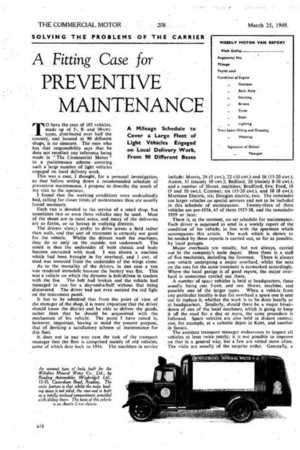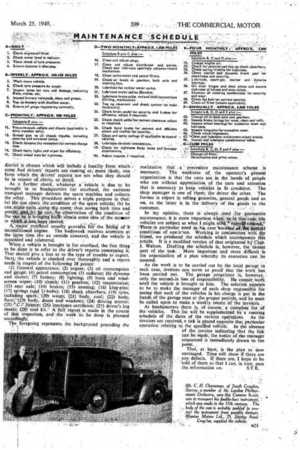A Fitting Case for
Page 24

Page 25

If you've noticed an error in this article please click here to report it so we can fix it.
PREVENTIVE MAINTENANCE
T0 have the care of 185 vehicles, made up of 5-, 8and t0-cwt. types, distributed over half the country, and located at 90 different shops, is no sinecure. The man who has that -responsibility says that he does not recollect any reference being made in "The Commercial Motor" to a maintenance scheme covering such a large number of light vehicles
engaged on local delivery work. .
This was a ease, I thought, for a personal investigation, so that before setting down a recommended schedule of preventive maintenance, 1 propose to describe the result of my visit to the operator.
I found that the working conditions were undoubtedly bad, calling for closer limits of maintenance than are usually found necessary.
Each van is devoted to the service of a retail shop, but sometimes two or even three vehicles may be used. Most of the shops are in rural areas, and many of the deliveries are to farms, or to houses in outlying districts.
The drivers 31wa,,s prefer to drive .across a field rather. than walk, and that sort of treatment is certainly not good for the vehicle. Whilst the drivers wash the machines, they do so only-, on the outside, not underneath. The result is that the undersides of both chassis and body become encrusted with mud. I was shown a machine which had been brought in for overhaul, and .1 cwt.. of mud was removed frbm"the undersides of the wings alone.
As to the mentality of the drivers, in one case a van was rendered immobile because the battery was flat. This was a vehicle on which the dynamo is belt-driven in tandem with the fan. The belt had broken and the vehicle had managed to run for a day-and-a-half without that being discovered. , The driver had not even noticed the red light on the instrument panel.
It has to be admitted that from the point of view of the manager of the shop, it is more important.that the driver should know the district and he able to deliver the goods, rather than that he should be acquainted with the mechanism of his vehicle. The point I have raised is, however, important, having in mind the present purpose, that of devising a satisfactory Scheme of maintenance for this fleet.
It does not in any way case the task of the transport manager that the fleet is comprised mainly of old vehicles, some of which date back to 1934. The machines in service include: Morris, 24 (5 cwt.), 22 (10 cwt.) and 16 (15-20 cwt.); Austin, 31 (mainly 10 cwt.); Bedford, 20 (mainly 8-10 cwt.), and a number of 30-cwt. machines; Bradford, five; Ford, 18 (5 and 10 cwt.); Commer, six (15-20 cwt.), and 18 (8 cwt.); Morrison Electric, six; Douglas electric, two. The remainder are larger vehicles on special services and not to be included in this schedule of maintenance. Twenty-three of these vehicles are pre-1936, 45 of them 1937-38, and the remainder 1939 or later.
There is, at the moment, no set schedule for maintenance. Each driver is supposed to send in a weekly report of the condition of his vehicle, in line with the specimen which accompanies this article. The work which is shown to be needed by these reports is carried out, so far as possible, by local garages.
Major overhauls are usually, but not always, carried out tt. the company's main depot. Here there is a staff of five mechanics, including the foreman. There is always one vehicle undergoing a major overhaul, whilst the next on the rota for the same treatment is earmarked accordingly. Where the local garage is of good repute, the major overhaul is sometimes carried, out there.
A number of spaie vehicles is held at headquarters, these usually being one 5-cwt. and one 10-cwt. machine, and possibly one of the larger types. When a vehicle from any particular locality is due for overhaul a spare one is sent out to replace it, whether the work is to be done locally or at headquarters. Similarly, should there be a major breakdown of one of the local machines, which is going to keep it off the road for a day or more, the same procedure is followed. Spare vehicles are also held at distant centro.,; one, for example, at a suitable depot in Kent, and another in Sussex.
The assistant transport manager endeavours to inspect all vehicles at least twice yearly; it is not possible to improve on that in a general way, but a few are vetted more often. The visits are usually of the surprise order. Generally, a
district is chosen which will include a locality from 'which -' some ,bad drivers' reports are coming or,, more likely, one from which the drivers' reports 'are not what they should be in reipect of .clarity or detail.
As a further cheek, wheneer a .Y vehicle is due to be brought in to headquarters ter overhaul, the assistant transport manager delivers the spare machine and collects the other. , This p-rocedure serves a triple purpose in that: (a) #e c_an check the..condition of the spare vehicle; (b) he can.tu along Vie-routethuS saving both time and c.an,:.by-oliservation of the condition of is bringitilliat Obtain some idea of the murex
•
petf.$1%. the 411
iiiiior-oyOatit usually providei'f3Ithe fitting of 'a reconditioned engine. The bodywork receives attention at the Same time (by an outside concern), And the vehicle is repainted and relettered. Whena vehicle is brought in for overhaul, the first thing to be clone is to refer to the driver's reports concerning it. That should give a line as to the type of trouble to expect. Next; the vehicle, is checked over thoroughly and a report made in respect of the following 28 points: (1) .General ,appearance; (2) engine; (3) oil consumption and gauge; (4) petrol consumption (5) radiator; (6) dynamo and starter; (7) battery; (8) lighting; (9) horn and windscreen-wiper; .(10) clutch; (11) gearbox; (12) transmission; (13) rear axle; (14) brakes; (15) steering; (16) king-pins; (17) springs (and U-bolts); (18) shock absorbers; (19) tyres, including spar (20). wings; (21) "body, roof; (22) body, floor; 23) body, doors and windows; (24) driving mirror;
licence .; (26) insurance certificate', (27) driver's log sheets; (28) idol kit.' A full report,is made in the course of this inspection, and the work to be done is planned accordingly.
The foregoing represents the background preceding the reali2ati6n that . a .• preY'entive maintenance scheme is necessary. The Weakness of, the operator's present organization is that the vans are in the hands of people who are without appreciation of the care and attention that is necessary• to keep vehicles in fit condition. The shop manager is one of the.m; the driver the other. The former is expert in selling groceries, general goods and so on, as the latter is in the delivery of the goods to the customer.
In my opinion, there is always r_need for .:preventive maintenance; it is more important whel".;,:iis:Tin. tips-casts (1k vehicles are subject to what I might tairt."'ictrie*cir*.W There is particular need in hi.s case 'hecalifie:-01:-4orrio. conditions of opera.ion. Working in conjunction with rfiy friend, we produced the schedule which accompanies this article. It is a modified version of that originated bt Capt. J. Walton. Drafting the schedule is, however, the 'easiest part of the task. More important and more difficult `is the organization of a plan whereby its execution can be assured.
As the work is to be carried out by the local garage in each case, invoices can serve as proof that the work has
been carried out. The garage proprietor is, however, only the second.in line of responsibility. He canoot,woik until the vehicle is brought to him. The solution appears to be to make the manager of each shop responsible for seeing that each of the vehicles in his charge is put in the hands of the garage man at the proper periods, and he must be called upon to make a weekly return .of" the invoices..
At headquarters there is, of 'course," a complete list of the vehicles. This list will be supplemented by a running schedule of the dates of the various Operations. As the invoices are received, a tick is placed opposite that particular operation relating to the specified vehicle. In ;he absence of the invoice indicating that the tick can be' made, the notice of the manager concerned is immediately drawn to the point..
That, at least, is the plan as now envisaged. Time will show if there are any defects. If there are, I hope to be told of them so that I can, in turn, pass
the information on. S.T.R.


























